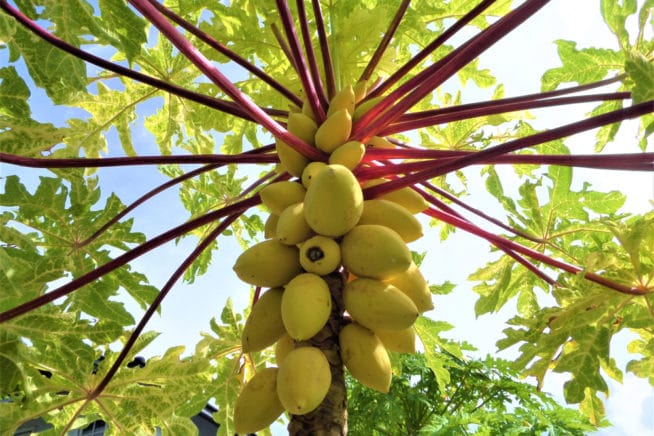
Imagine biting into a sweet, juicy papaya, its vibrant orange flesh bursting with tropical flavor. You might picture yourself on a sun-drenched beach, but did you ever wonder where that delicious fruit actually came from? Believe it or not, papaya cultivation thrives in certain corners of the United States. Let's explore the fascinating world of papaya farming and discover which states lead the way in growing this exotic delight.
The Papaya Landscape in the United States
While papayas conjure images of tropical paradises, their cultivation within the U.S. is fairly limited due to their sensitivity to frost and cooler temperatures. Papayas are not grown in the majority of states, as their growth is limited to warmer states such as Florida, Hawaii, California, and Texas.
The commercial production of papayas requires a specific climate with consistent warm temperatures and ample sunlight. Areas prone to freezing temperatures are unsuitable, necessitating the use of greenhouses or other protective measures, which can significantly increase production costs. Therefore, the states that grow the most papayas are those with the most suitable natural conditions.
Which State Grows the Most Papayas: Hawaii's Dominance
Hawaii stands head and shoulders above the rest when it comes to commercial papaya production. The Aloha State boasts a climate perfectly suited for these tropical fruits to thrive. The consistent warmth, abundant sunshine, and fertile volcanic soil create ideal growing conditions, allowing for year-round harvests. Hawaii’s papaya industry is a significant contributor to the state's agricultural economy. Factors, such as geographic conditions, growing climate, and consumer behavior influence the growth rate of papayas in this state.
Key Facts About Hawaii's Papaya Production
- Hawaii accounts for the vast majority of U.S. papaya production.
- The state's papaya industry has a long and rich history, dating back centuries.
- Major papaya growing regions include the Big Island, Oahu, and Kauai.
- Hawaiian papayas are known for their exceptional sweetness and flavor.
While other states experiment with smaller-scale papaya cultivation, Hawaii remains the undisputed leader in the United States. It's where you'll find the most substantial commercial papaya farms and the widest availability of locally grown fruit. The state has become synonymous with papaya farming due to their unique advantages in temperature and sunlight.
Florida: A Rising Star in Papaya Cultivation
Florida, with its subtropical climate, presents another promising location for papaya cultivation within the United States. While not as dominant as Hawaii, Florida's papaya industry has been steadily growing in recent years. South Florida, in particular, offers favorable conditions for growing papayas, with its warm temperatures and abundant rainfall. However, Florida's papaya growers face challenges such as occasional freezes, which can damage crops and require protective measures.
Florida has some of the most innovative farming research and farming practices in the country, and they make significant investments to ensure that the growing process is streamlined and the output remains high.
Key Facts About Florida's Papaya Production
- South Florida is the primary papaya-growing region in the state.
- Florida papayas are typically grown for local consumption and regional markets.
- Growers are exploring new varieties and cultivation techniques to improve yields and frost resistance.
- The Florida Department of Agriculture and Consumer Services supports the state's papaya industry through research and promotion.
Although Florida is not the state that grows the most papayas, its industry has seen growth, demonstrating the potential of other states to grow papayas in the future.
California and Texas: Niche Papaya Production
While Hawaii and Florida lead the way in commercial papaya production, California and Texas have pockets of growers cultivating papayas on a smaller scale. In California, favorable microclimates in Southern California allow for limited papaya production, primarily for local markets and specialty growers. Similarly, South Texas offers suitable conditions for papaya cultivation, with growers experimenting with different varieties and techniques.
Challenges and Opportunities
Papaya cultivation in California and Texas faces unique challenges due to climate variability, water availability, and market competition. However, there are also opportunities for niche growers who can cater to specific consumer demands, such as organic or locally grown papayas. These states are able to have niche papaya production because of advances in indoor agriculture, which can artificially provide the right conditions for papayas to flourish.
The Future of Papaya Farming in the United States
The future of papaya farming in the United States looks promising, with ongoing research and innovation driving progress in cultivation techniques, pest and disease management, and variety development. As consumers increasingly seek out fresh, tropical fruits, the demand for locally grown papayas is likely to increase. This could lead to further expansion of papaya cultivation in states with suitable climates and the development of new growing regions. Papayas are an increasingly important crop to farmers across the country, as they offer a new opportunity to diversify and cater to consumer tastes. More research and grants are being allocated toward papayas to allow for more efficient and sustainable production.
Promotional Content
After a long day of tending to your papaya plants, why not take a load off with the versatile KVR Upgraded Garden Kneeler and Seat, which features a comfy, thick kneeling pad? This foldable gardener stool will be a welcome addition to your gardening kit! It also makes a thoughtful gift for the gardeners in your life. You can find the KVR Upgraded Garden Kneeler and Seat here: https://amzn.to/4mhl Mx I.